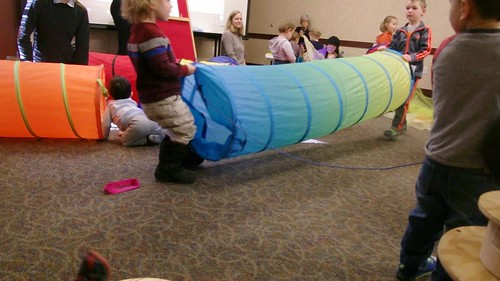This is a continuation of part 1, posted last week:
1.
What
about the other kid’s parent?
When your child is playing at a park or
playground and experiences conflict with another child, one of the most
uncomfortable elements for many parents is not knowing the other child’s
parent’s tolerance for conflict. Is that parent going to get mad if you don’t
step in and smooth the situation? Is the other parent going to step in and try
to handle the situation in a way that you don’t like? Are they going to judge you a “bad parent”
for not managing your child’s behavior? One of the great things about being in an
Anji Play experience is that all parents are given the same guidelines about
allowing kids to work it out themselves.
Pay close attention to disagreements, step in if they escalate to a
physically harmful stage, but otherwise, relax and realize that ALL kids struggle with
figuring out how to solve interpersonal problems sometimes (heck, we ALL do,
not just kids!) and they need a chance to figure out how other people react to different
behaviors and find their own solutions.
note: after this video ended, the taller boy found a different tunnel to play with almost immediately and found a different spot to play in.
2.
My
kid is used to me stepping in to help solve conflict, this sudden change in my
behavior will feel disorienting to them!
If you’re worried that your child
will feel betrayed or abandoned if you don’t step in on their behalf, feel free
to have a brief, frank conversation with them at the beginning of the event and
let them know that in this space, kids are in charge of solving their own
problems and that you trust them to come up with great solutions to any
problems they might encounter during the program. (Psst…librarians or other program leaders,
YOU can talk directly to the kids at the beginning of the program to set up
this expectation for them. You don’t
have to leave this conversation just up to the parents and caregivers!)
3.
If
conflict is happening frequently, there’s probably a problem in the environment
or materials set-up.
Librarians or program leaders, pay
attention! If you notice that kids are
behaving in ways you don’t want them to, think about ways that you can change
the environment. Are the kids climbing
on stuff they’re not supposed to climb on?
Remove that option. Are they
breaking toys? Change the toys to ones that are less breakable and more engaging. When kids are deeply
engaged in the play, they are much less likely to behave in ways that are
challenging for adults. Boredom and
frustration have a huge factor in behavior.
Is there enough space to play in? Crowding can amplify personality tendencies and can be overstimulating, so consider moving into a larger area or limiting attendance (I learned this the hard way!). Are the play materials too simplistic? Boooooring! Too challenging? Aaaaaaargh! It’s a tricky balance to find and
one that takes close observation of the kids to properly curate the right mix
of play materials for your particular group.
But that’s a topic for another post.
Please note: "Anji Play,” refers to a specific philosophy and comprehensive approach to early education developed by Ms. Cheng Xueqin in Anji County, China. I use the term "Anji Play" to describe my programming and throughout this blog with the explicit permission of Ms. Cheng because our programming has been developed as part of a close collaborative relationship with her and her team of Anji Play educators. If you are interested in learning more about how you can bring Anji Play to your community, please visit www.anjiplay.com
Please note: "Anji Play,” refers to a specific philosophy and comprehensive approach to early education developed by Ms. Cheng Xueqin in Anji County, China. I use the term "Anji Play" to describe my programming and throughout this blog with the explicit permission of Ms. Cheng because our programming has been developed as part of a close collaborative relationship with her and her team of Anji Play educators. If you are interested in learning more about how you can bring Anji Play to your community, please visit www.anjiplay.com


No comments:
Post a Comment